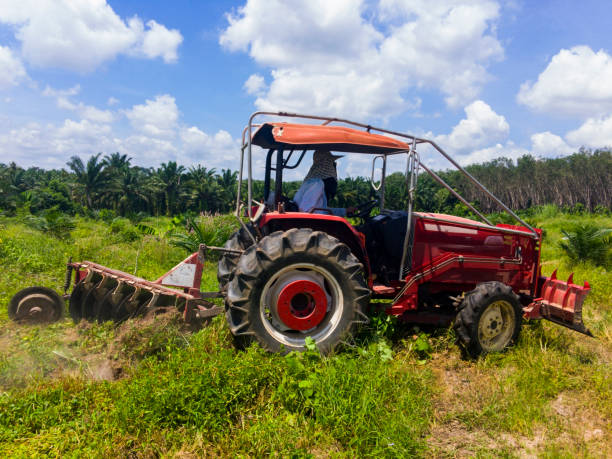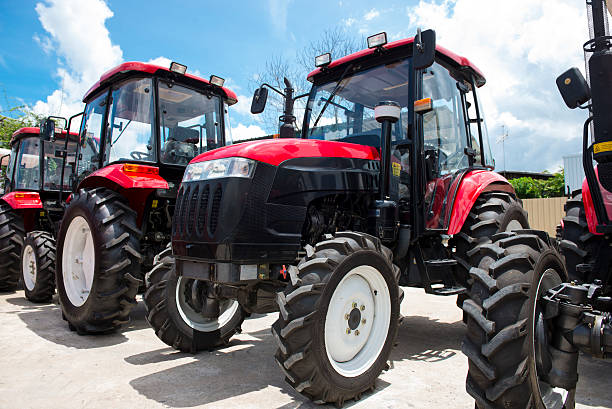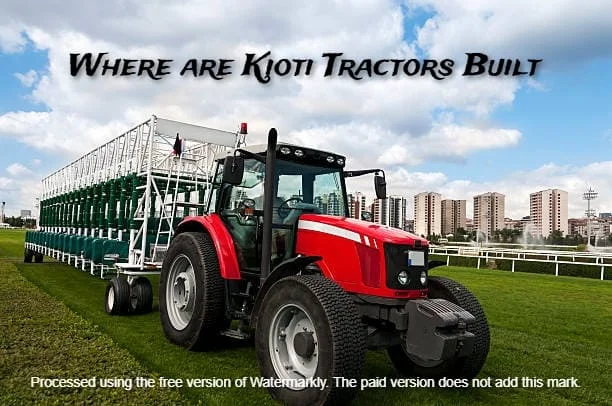Kioti Tractors are built in South Korea by Daedong Industrial Company, Ltd., a well-established manufacturer known for high-quality agricultural machinery. With over 70 years in the industry, Daedong produces Kioti tractors for global distribution, including assembly and distribution operations in North America, primarily through their facility in Wendell, North Carolina.
Introduction
Kioti tractors have become increasingly popular in the agricultural and construction sectors, known for their reliability, performance, and competitive pricing. This comprehensive guide explores the manufacturing locations of Kioti tractors, delving into the company’s history, production facilities, and global presence. Understanding where these machines are built provides valuable insights into their quality standards and the company’s commitment to excellence in manufacturing.

Daedong Industrial Company Background
Kioti tractors are manufactured by Daedong Industrial Company, Ltd., a South Korean corporation with a rich history dating back to 1947. The company began its journey in agricultural machinery production shortly after World War II, when South Korea was rebuilding its industrial capacity.
Evolution into Global Markets
In the 1980s, Daedong began expanding its reach beyond South Korea, establishing itself in international markets. The Kioti brand was specifically created for the North American market in 1993, marking a significant milestone in the company’s global expansion strategy.
Primary Manufacturing Facilities
South Korean Production Centers
Daegu Manufacturing Complex
The primary manufacturing facility for Kioti tractors is located in Daegu, South Korea. This state-of-the-art facility spans:
| Facility Component | Size (Square Feet) | Year Established |
|---|---|---|
| Main Assembly Plant | 2,000,000 | 1993 |
| Research Center | 150,000 | 1995 |
| Testing Grounds | 500,000 | 1994 |
The Daegu facility employs over 2,500 workers and incorporates:
- Advanced robotics and automation systems
- Quality control laboratories
- Environmental sustainability measures
- Modern assembly lines
Yangsan Production Facility
A secondary production facility in Yangsan focuses on:
- Component manufacturing
- Transmission assembly
- Engine production
- Specialized equipment assembly
North American Operations
North Carolina Distribution Center
While not a manufacturing facility, Kioti’s North American headquarters in Wendell, North Carolina, plays a crucial role in:
- Product distribution
- Parts warehousing
- Technical support
- Customer service
- Training facilities

Manufacturing Process and Quality Control
Component Sourcing
Kioti maintains strict quality control over its components through:
- In-house manufacturing of critical parts
- Strategic partnerships with verified suppliers
- Rigorous testing protocols
- Quality assurance checkpoints
Assembly Line Operations
Main Production Stages
- Frame Assembly
- Welding and structural integrity testing
- Corrosion protection application
- Quality inspection points
- Powertrain Installation
- Engine mounting and alignment
- Transmission integration
- Hydraulic system installation
- Cabin and Controls
- Ergonomic design implementation
- Electronics installation
- Climate control system integration
- Final Assembly
- Wheel and tire mounting
- Implement attachment testing
- Systems calibration
Quality Assurance Protocols
Testing Procedures
Each tractor undergoes:
| Test Type | Duration | Components Tested |
|---|---|---|
| Structural | 48 hours | Frame, chassis |
| Performance | 24 hours | Engine, transmission |
| Hydraulic | 12 hours | All hydraulic systems |
| Electronic | 8 hours | All electrical components |
| Field | 6 hours | Overall operation |
Global Market Presence
Distribution Networks
International Markets
Kioti tractors are distributed in:
- North America
- Europe
- Australia
- South America
- Asia
Market Share Analysis
| Region | Market Share % | Year-over-Year Growth |
|---|---|---|
| North America | 15% | +2.5% |
| Europe | 8% | +1.8% |
| Asia Pacific | 25% | +3.2% |
| Other Markets | 5% | +1.5% |
Product Range and Specialization
Tractor Categories
Compact Tractors
- CS Series (21-25 HP)
- CK Series (25-40 HP)
- DK Series (45-55 HP)
Utility Tractors
- RX Series (66-73 HP)
- PX Series (90-110 HP)
Specialty Models
- Narrow Track Series
- Orchard Series
- Rice Farming Models
Manufacturing Specifications
Each series is manufactured with specific features catering to different market needs:
| Series | Primary Use | Manufacturing Focus |
|---|---|---|
| CS | Residential | Maneuverability |
| CK | Small Farms | Versatility |
| DK | Commercial | Durability |
| RX | Agricultural | Power |
| PX | Industrial | Heavy-duty |
Innovation and Technology
Research and Development
R&D Centers
- Daegu Technical Center
- Engine development
- Transmission research
- Alternative fuel studies
- North Carolina Innovation Hub
- Market-specific adaptations
- User interface development
- Implementation testing
Technological Advancements
Recent Innovations
- Electronic fuel injection systems
- Advanced hydraulic controls
- GPS integration capabilities
- Eco-friendly engine designs
Environmental Commitment
Sustainable Manufacturing
Green Initiatives
- Energy Conservation
- Solar power integration
- LED lighting systems
- Heat recycling programs
- Waste Reduction
- Materials recycling
- Water conservation
- Emissions control
Environmental Certifications
| Certification | Year Achieved | Scope |
|---|---|---|
| ISO 14001 | 2005 | Environmental Management |
| Green Factory | 2012 | Production Processes |
| Energy Star | 2015 | Facility Operations |
Future Manufacturing Plans
Expansion Projects
Planned Developments
- Manufacturing Capacity
- New assembly lines
- Automated systems upgrade
- Quality control enhancement
- Geographic Expansion
- European facility consideration
- Australian distribution center
- South American partnerships
Technology Integration
Future Implementation
- Industry 4.0 adoption
- AI-driven quality control
- IoT integration in production
- Predictive maintenance systems
Customer Support and Service
Global Service Network
Support Infrastructure
- Technical Support Centers
- Factory-trained technicians
- Parts distribution
- Warranty services
- Dealer Network
- Certified service providers
- Training programs
- Parts inventory
Impact on Local Economies
Employment and Community
Economic Contributions
- Direct Employment
- Manufacturing jobs
- Support positions
- Administrative roles
- Indirect Benefits
- Supplier networks
- Local services
- Community development
Industry Comparisons and Market Position
Competitive Analysis
Manufacturing Advantages
- Production Efficiency
- Automated assembly lines
- Integrated quality control
- Modern robotics implementation
- Lean manufacturing principles
- Cost Benefits
- Vertical integration
- Strategic supplier relationships
- Economies of scale
- Optimized logistics
Market Differentiation
| Feature | Kioti | Industry Average |
|---|---|---|
| Warranty Coverage | 6 years | 3-4 years |
| Quality Control Steps | 15+ | 8-10 |
| Manufacturing Automation | 75% | 60% |
| Sustainable Practices | Advanced | Standard |
Regional Manufacturing Impact
Asian Manufacturing Hub
- Supply Chain Integration
- Local component suppliers
- Regional distribution networks
- Technical expertise concentration
- Research collaboration
- Economic Benefits
- Employment generation
- Skills development
- Industrial growth
- Export revenue
Manufacturing Certifications and Standards
International Compliance
Quality Standards
| Certification | Purpose | Renewal Frequency |
|---|---|---|
| ISO 9001 | Quality Management | 3 years |
| CE Mark | European Compliance | Ongoing |
| ASAE Standards | Agricultural Equipment | Annual |
| OSHA Compliance | Safety Standards | Continuous |
Safety Protocols
Manufacturing Safety
- Worker Protection
- Personal protective equipment
- Safety training programs
- Emergency response systems
- Regular safety audits
- Product Safety
- Design safety reviews
- Component testing
- Operational safety features
- User safety documentation
Component Manufacturing Details
In-House Production
Critical Components
- Engine Assembly
- Block casting
- Cylinder head manufacturing
- Crankshaft production
- Timing system assembly
- Transmission Systems
- Gear cutting
- Housing manufacture
- Assembly line testing
- Quality verification
Outsourced Components
Supplier Management
| Component Type | Supplier Location | Quality Check Points |
|---|---|---|
| Electronics | South Korea, Japan | 12 |
| Hydraulics | Germany, USA | 8 |
| Tires | South Korea, USA | 6 |
| Cabin Materials | South Korea | 10 |
Training and Workforce Development
Manufacturing Excellence
Employee Training Programs
- Technical Skills
- Assembly procedures
- Quality control methods
- Equipment operation
- Maintenance protocols
- Safety Training
- Workplace safety
- Emergency procedures
- Environmental compliance
- Health regulations
Continuous Improvement
Development Initiatives
| Program Type | Duration | Frequency | Participants |
|---|---|---|---|
| Basic Skills | 2 weeks | Monthly | New Hires |
| Advanced Tech | 3 months | Quarterly | Technicians |
| Leadership | 6 months | Annually | Supervisors |
| Quality Control | 1 month | Bi-monthly | QC Staff |
Global Supply Chain Integration
Logistics Network
Transportation Hub
- Sea Routes
- Main shipping ports
- Container specifications
- Transit times
- Quality preservation
- Land Transport
- Regional distribution
- Dealer delivery
- Parts logistics
- Emergency shipping
Inventory Management
Global Stock Control
| Location | Storage Capacity | Inventory Turnover |
|---|---|---|
| South Korea | 50,000 units | 45 days |
| North America | 15,000 units | 30 days |
| Europe | 8,000 units | 35 days |
| Australia | 5,000 units | 40 days |
Production Customization Capabilities
Market-Specific Modifications
Regional Adaptations
- Climate Considerations
- Cold weather packages
- Tropical conditions
- Desert operations
- High-altitude performance
- Agricultural Requirements
- Crop-specific attachments
- Soil type adaptations
- Local farming practices
- Regional regulations
Special Editions
Custom Manufacturing
| Model Type | Special Features | Production Time |
|---|---|---|
| Vineyard | Narrow design | +5 days |
| Arctic | Cold resistance | +7 days |
| High Altitude | Engine modification | +6 days |
| Rice Paddy | Track system | +8 days |
Quality Testing and Verification
Testing Facilities
Laboratory Equipment
- Environmental Testing
- Temperature extremes
- Humidity resistance
- Salt spray exposure
- UV degradation
- Performance Testing
- Engine dynamometer
- Transmission load
- Hydraulic pressure
- Electronic systems
Field Testing Programs
Real-World Validation
| Test Type | Duration | Conditions Tested |
|---|---|---|
| Endurance | 500 hours | Continuous operation |
| Climate | 200 hours | Weather extremes |
| Load | 300 hours | Maximum capacity |
| Terrain | 250 hours | Various surfaces |
Conclusion
Kioti tractors’ manufacturing journey, centered in South Korea with significant global reach, demonstrates the company’s commitment to quality, innovation, and customer satisfaction. The state-of-the-art facilities in Daegu and Yangsan, combined with strategic distribution networks worldwide, position Kioti as a significant player in the agricultural machinery market. Their focus on sustainable manufacturing practices, continuous technological advancement, and strong quality control measures ensures the production of reliable and efficient tractors that meet diverse market needs.
FAQs
Are Kioti tractors made in China?
No, Kioti tractors are manufactured by Daedong Industrial Company in South Korea, with primary manufacturing facilities located in Daegu and Yangsan. While some components may be sourced globally, the main assembly and production take place in South Korean facilities.
How long has Kioti been manufacturing tractors?
Daedong Industrial Company, which manufactures Kioti tractors, has been in operation since 1947. However, the Kioti brand was specifically established for the North American market in 1993.
What is the quality control process for Kioti tractors?
Each Kioti tractor undergoes extensive quality control testing, including structural, performance, hydraulic, electronic, and field testing. The total testing process can take up to 98 hours per unit before approval for distribution.
Does Kioti have manufacturing facilities in North America?
While Kioti maintains a significant presence in North America through its headquarters in Wendell, North Carolina, this facility serves as a distribution center rather than a manufacturing plant. All Kioti tractors are manufactured in South Korea.
What is the manufacturing capacity of Kioti’s facilities?
The main manufacturing facility in Daegu spans approximately 2 million square feet and employs over 2,500 workers. The facility can produce thousands of tractors annually, though exact production numbers are not publicly disclosed.

